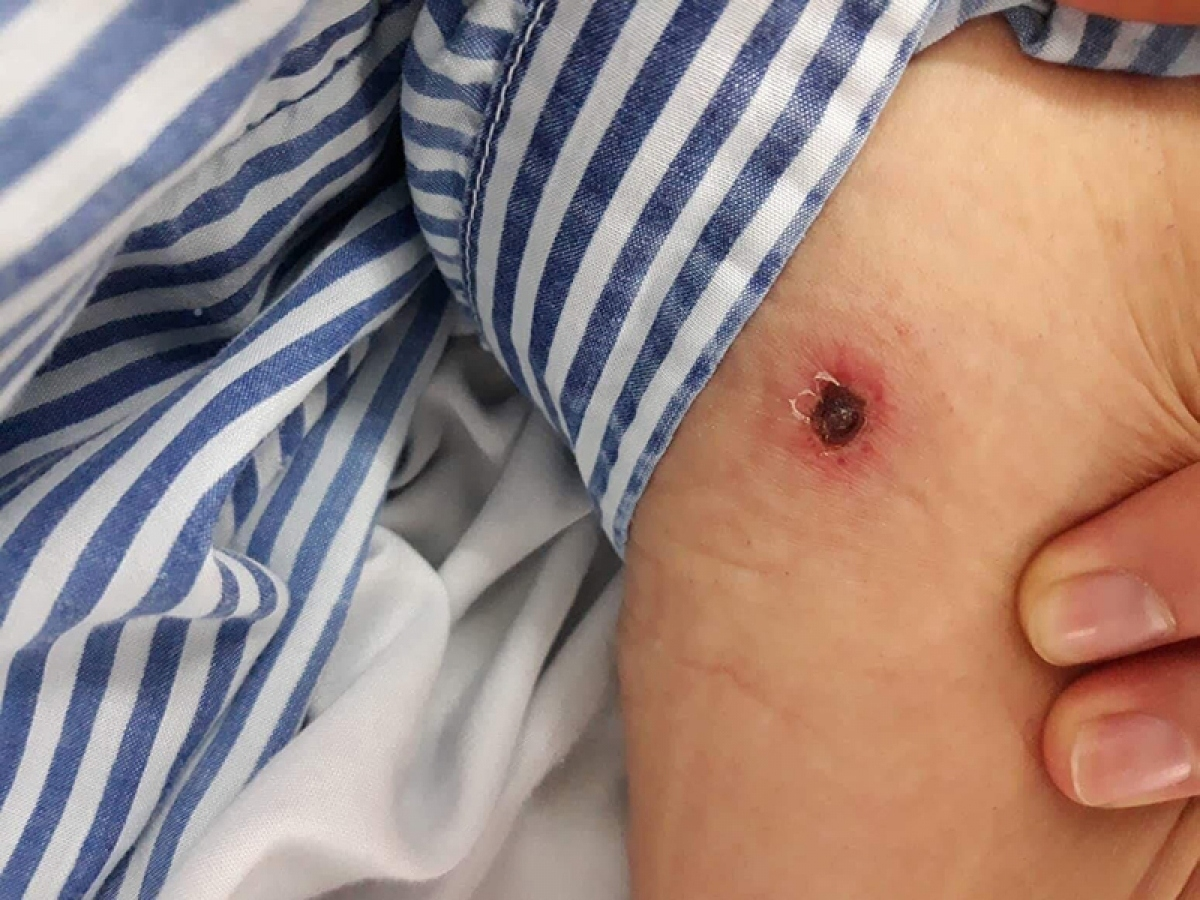Scrub typhus is an acute fever that often occurs in hot and humid weather. If not detected early, it can cause damage to the heart, liver, kidneys, and even encephalitis and death.
Nguyen Thanh Tung, 17 years old, in Phuc Ninh commune, Yen Son district, after going into the forest to catch honey bees, had a continuous high fever. Although Tung went to the commune health station and the district health center for examination, the fever did not decrease, at times reaching over 40 degrees, accompanied by symptoms of headache and red eyes.
Ms. Nguyen Thi Hoa - Tung's mother said that at first the family thought Tung had Covid-19 so they gave him fever-reducing medicine and IV fluids at the medical station. However, he continued to have a fever for a week. Fearing that he had a serious illness, the family took Tung to Tuyen Quang Provincial General Hospital.

After asking about his medical history and examining him, the doctors discovered a black crusted ulcer on Tung's flank, similar to the symptoms of scrub typhus. This was the first time Hoa's family had heard of this disease.
“I had never heard of or known about this disease. After coming here, the doctor treated my child and after 2 days, his fever went away. Now he is healthy and normal…”, Ms. Hoa shared.
According to Dr. Doan Thi Thuy Tinh, Deputy Head of the Department of Internal Medicine, Tuyen Quang General Hospital, tick fever often occurs during the hot rainy season from May to October when people go to the forest to catch bees, or tourists go to areas with dense bushes, easily being stung by ticks and causing fever. However, the symptoms are easily confused with common fever, so they are not detected early.
“The patient had been in a fever for a week at home, had been treated at the commune and ward health stations but did not improve, had a constant fever of 39, 40 degrees. No cough, just fever and fatigue, no signs of infection…” - Dr. Thuy Tinh said.
In addition to the case of patient Tung, Tuyen Quang General Hospital also received another case of tick fever due to returning from the forest. Fortunately, both patients were discovered in time and did not have any dangerous complications.
Signs of tick fever
According to Associate Professor, Dr. Nguyen Dang Manh - Director of the Institute of Clinical Infectious Diseases, Central Military Hospital 108, scrub typhus is an infectious disease caused by the rickettsia tsutsugamushi bacteria. Scrub typhus is common in rural areas, forest edges, riverbanks, streams where there are many trees and bushes. People of all ages can get the disease, but mainly in working age. The source of the disease is animals such as rats, dogs, cats, pigs, chickens. The vector of the disease is the mite larvae.
Mite larvae often choose to bite soft, moist skin areas such as the genitals, anus, armpits, groin, neck, and eyelids. Because the bite is painless, the patient often does not pay attention. However, after being bitten for 6-12 days, the patient begins to develop the disease, with symptoms of continuous high fever, headache, body aches, fatigue, skin and eye congestion, and possibly a red rash on the skin. At first, at the site of the mite larvae bite, there are pea-sized blisters, then the bite becomes a black scab and when the scab peels off, it forms a small, concave ulcer.
Scrub typhus often has symptoms similar to those of flu, rash fever, and dengue fever, so it is difficult to distinguish it from other fevers. If scrub typhus is not treated with antibiotics early and appropriately, it can progress to serious complications leading to multiple organ failure including respiratory failure, circulatory failure, liver failure, kidney failure, blood clotting disorders, and can lead to death.
Associate Professor, Dr. Nguyen Dang Manh emphasized the following characteristics of tick fever:
People with epidemiological factors such as just returning from dense forests, rivers, or streams.
There are symptoms of high fever of 39-40 degrees continuously. May be accompanied by symptoms of headache, fatigue, skin and eye congestion, and red rash on the skin.
On the body there are ulcers caused by insect bites in private areas such as armpits, groin, genitals... The ulcers are round or oval with a diameter of 1mm to 2cm. If there are scales, the black, hard scales cover a papule with a hard edge. Notably, the ulcers do not cause pain or itching and have swollen lymph nodes around them.

When these signs appear, patients need to go to medical facilities immediately for timely treatment. Associate Professor, Dr. Nguyen Dang Manh also said that there are only a few types of classic antibiotics that are specific to scrub typhus. New, popular antibiotics today are often ineffective. Therefore, people should not self-treat at home to avoid possible dangerous complications.
How to prevent tick fever
Actively clear the area around the house, clean up weeds, overgrown trees, and kill rats and rodents. Clear drains, and periodically spray insecticide every 6 months.
Do not lie or dry clothes in damp places to avoid larvae clinging to them.
When visiting or working in the forest, be careful to avoid resting under dense vegetation, weeds, or humus. Do not lie on the ground. Wear modest clothing and high boots. Apply insect repellent to exposed skin.
When having high fever of unknown cause, you need to carefully check all skin surfaces on your body for strange bites, then take yourself to a medical facility early so that doctors can examine, diagnose and treat you promptly to avoid unfortunate consequences.
According to vov.vn
Source link





























































































Comment (0)